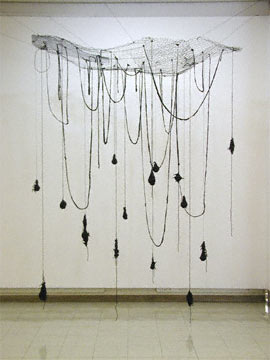
YaYa Chou, 'Allelopathy,' 2009, crocheted licorice lace,
rubber coated fibers and painted chicken wire
“Pretty: Disturbing” brings together Nancy Harlan and Pamela Grau Twena (co-curators), Miriam Wosk and YaYa Chou. Their work is related by their inventive use of material, their often dense “more is more” aesthetic, and their gender sensibilites--hence, “pretty.” The oxymoronic and slightly enigmatic titles begs the question “When is pretty disturbing?”
Grau Twena and Harlan hand-dye the lowly supermarket plastic bag, transforming this most ordinary and ubiquitous item into a shimmering, eye-candy colored ocean in a site specific piece entitled “Pacific Vortex” (1,000 dyed plastic bags, 16 feet square). Consisting of thousands of glowing Easter egg colored bags, this commonplace item of post-consumer waste, though reconfigured, reused and readapted, nonetheless serves as an ominous reminder of the ocean becoming increasingly clogged with trash and waste material. We are left to imagine the day when the seven seas will be just plastic landfill, a “pretty disturbing” post-apocalyptic idea.
Harlan continues this theme with “Cost of Convenience” (5’ x 4’, dyed plastic bags, wooden hangers), in which she hangs dyed plastic bags by their handles on wooden hangers, like so many tank tops in a store. This piece invokes the homeless, suggesting people who have to “fashion” their clothes and their homes from the public’s leftovers and ever-abundant trash. “Tapestry” (8’ x 20’, 1,000 plastic rings, marker) is a wall hanging of one thousand plastic holders for coke and beer that Harlan connects like a chain link fence. Thoughts, feelings and events are written on this piece, making it a visual diary as well.
Wosk creates a more traditional tapestry with “Big Red” (Jacquard Tapestry with metallic thread and Swarovski crystals, applied by hand, Magnolia Editions, Edition of 8, 92” x 65 1/2”), which is elaborate, dazzling and intricate. This tapestry and her other large-scale collages reference botany, anatomy, and biological forms. Highly patterned and ornamental, both the tapestry and collages share a similar structure. A central image--in the tapestry it is a lobster, in the collages it is the human form or a singular undulating serpent--is overlaid on a complex background made up of tiny parts.
The repetition and rhythm of the hundreds of these small, mosaic-like parts is an element that is common in all the artists’ work here. However the dense, flowery, and intricate compositions are somewhat of an anomaly in this show, as the materials she uses are high end (crystals and silver thread) and not found in supermarkets or dumpsters. Wosk is clearly in the “pretty” camp here.
Chou, known for her wonderfully inventive gummi-bear chandeliers, works her magic with crocheted licorice in an installation entitled “Allelopathy“ (crocheted licorice lace, rubber coated fibers and painted chicken wire, dimensions variable). By definition this refers to the inhibition of the growth of a plant due to bio-molecules released by another, more invasive species. Chou often uses candy, as it is non-nutritious but highly tempting with its seductive color, transparent glowing surface and sweet smell. Large loops of black licorice snake around, loop and droop enclosing space like a John Altoon drawing. Large, seed-like pods of crocheted licorice hang, tempting like the apple from the Tree of Knowledge. Chou seems to suggest that we humans are the invasive species, inhibiting the natural course of evolution due to our tinkering with genetically engineered food and seeds.
“Pretty: Disturbing” is funny, engaging and provocative as these four artists take us through a magical mystery tour of the supermarket and our trash cans.
Published courtesy of ArtScene
